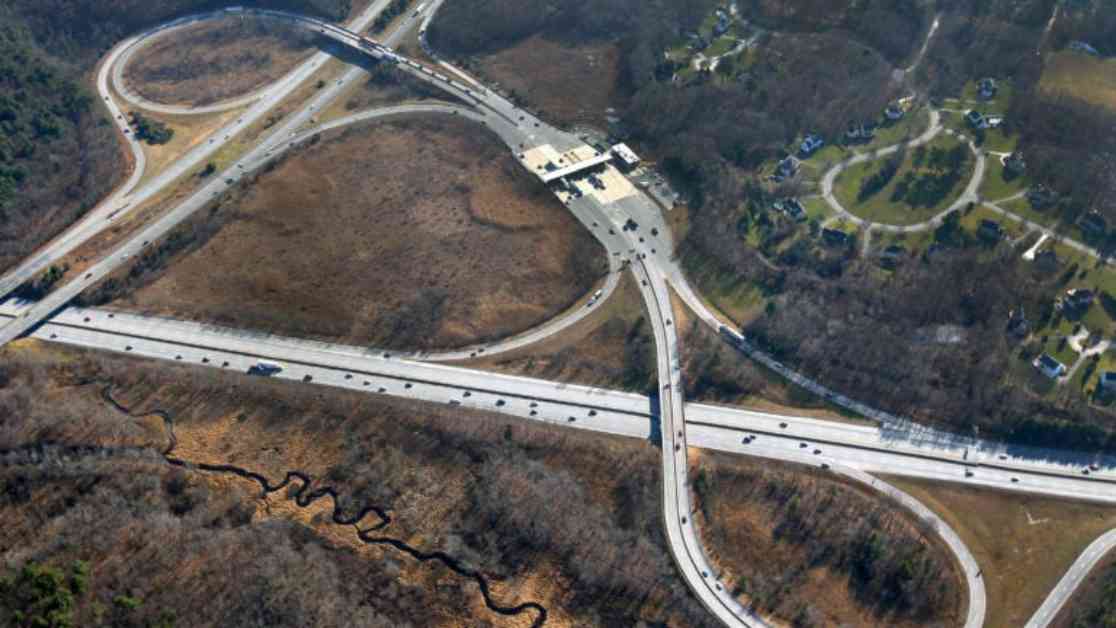As the sun rose on a crisp November morning, commuters on the busy Mass Pike were met with an unexpected obstacle: a large crack had appeared on Interstate 495 between Hopkinton and Westborough. This unforeseen development led to the closure of the westbound lanes of the Mass Pike for emergency repairs, causing disruptions and delays for travelers. Jonathan Gulliver, the highway administrator for the Massachusetts Department of Transportation, addressed the situation at a press conference, providing insight into the swift response to the issue.
Gulliver recounted how the crack was initially discovered by a vigilant MassDOT contractor who noticed unusual pavement cracking at 7 a.m. Upon inspection, it was determined that there were settlement issues that posed a risk of a potential sinkhole forming—a scenario that could have had disastrous consequences for motorists. In a proactive move to ensure public safety, the decision was made to close the affected roadway immediately and commence emergency repairs.
The root cause of the crack was attributed to an ongoing construction project at the I-495/I-90 interchange, a significant endeavor that the state had invested $440 million into. Piles had been installed near the section of the turnpike where the crack surfaced, causing movement in the soil due to the construction and traffic activity in the area. This movement ultimately led to the formation of the crack, prompting the need for urgent intervention to stabilize the embankment.
To address the issue, MassDOT mobilized dump trucks loaded with structural fill to reinforce the embankment and prevent further deterioration. The repair work was expected to continue throughout the day, with the aim of reopening at least one lane by 2 p.m. and restoring full access by 8 p.m. In the meantime, westbound traffic was diverted to Route 9 at Exit 111 in Framingham, leading to anticipated delays as road crews worked diligently to resolve the situation.
Despite the inconvenience caused by the partial closure of the Mass Pike, Gulliver expressed gratitude for the cooperation and understanding of the public as they navigated the temporary detours and adjusted their travel plans accordingly. The collaborative effort between MassDOT, construction crews, and commuters exemplified the resilience and adaptability of the community in the face of unexpected challenges on the road.
Expert Insights on Infrastructure Maintenance and Emergency Response
Offering insights into the broader implications of infrastructure maintenance and emergency response, transportation experts emphasize the critical importance of proactive monitoring and timely intervention to address potential hazards on highways and roadways. According to Dr. Sarah Johnson, a civil engineering professor specializing in transportation infrastructure, the incident on the Mass Pike underscores the need for regular inspections and maintenance to ensure the safety and integrity of vital transportation corridors.
“Cracks and settlement issues can escalate quickly if left unchecked, posing serious risks to public safety and the stability of the infrastructure,” Dr. Johnson explains. “By promptly identifying and addressing these issues, transportation authorities can prevent catastrophic failures and minimize disruptions to travel patterns.”
Lessons Learned and Future Preparedness
As commuters reflect on the temporary closure of the Mass Pike and the swift response by MassDOT to address the crack on Interstate 495, there is a renewed awareness of the interconnectedness of infrastructure maintenance and everyday travel experiences. The incident serves as a reminder of the fragility of our transportation systems and the importance of investing in resilient infrastructure that can withstand unexpected challenges.
Looking ahead, transportation agencies are expected to enhance their monitoring protocols and emergency response strategies to mitigate risks and ensure the continuous operation of critical transportation networks. By learning from incidents like the crack on the Mass Pike, authorities can proactively prepare for similar scenarios in the future, safeguarding the safety and efficiency of travel for all road users.
In conclusion, the partial closure of the Mass Pike near I-495 due to a crack serves as a poignant reminder of the dynamic nature of transportation infrastructure and the collaborative efforts required to address unforeseen challenges on the road. Through effective communication, swift action, and public cooperation, communities can navigate disruptions and emerge stronger, with a renewed commitment to ensuring the resilience and safety of our vital transportation networks.






